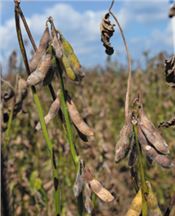|
Louisiana Soybean Crop Beats Expectations

Soybeans ready for harvest.
Photo by Bruce Schultz, LSU AgCenter
ALEXANDRIA, LA.
The 2015 Louisiana soybean crop was not as good as in recent years, but the results were better than expected after weather extremes of flood and drought.
“Overall, the crop was not as good as we’ve had in the last three or four years but still overall yields were good for Louisiana,” said LSU AgCenter soybean specialist Ron Levy.
Levy projected this year’s average statewide yield at slightly more than 40 bushels an acre, far below last year’s state record crop of 57 bushels an acre that led the nation.
The U.S. Department of Agriculture’s November estimates place average soybean yields for Louisiana in 2015 at 41 bushels per acre, more than 7 bushels below the national average and below Louisiana’s five-year average of 45.7 bushels.
This year Louisiana farmers harvested 1.41 million acres, with 1.5 million acres planted. Last year’s harvested acreage was 1.39 million acres.
Heavy rains at planting time created difficulties getting a stand established, Levy said. Wet ground also inhibited deep root growth, which made it difficult for plants to get adequate moisture during a late-season drought.
Wet conditions at planting left only a small window of time to put seed in the ground, Levy said, and that also resulted in a narrow window for harvesting because the crop matured at the same time. “It put a lot more additional stress on farmers.”
Some fields that were planted were not harvested. Drought stress prevented soybeans from maturing in some fields, he said, and many soybean fields in northwest Louisiana were lost to flooding.
The dry summer meant less disease, Levy said, but insect pressure from loopers and stinkbugs was severe in some areas.
More farmers were using irrigation because of a shift from corn on land that has been irrigated. Levy said he also noticed a slight increase in the use of LibertyLink soybeans to fight weeds that have become resistant to glyphosate herbicide.
Because of the weather extremes, no varieties stood out as top performers in commercial fields or LSU AgCenter demonstration plots, Levy said. “None of them could perform at their highest potential.”
Soybeans remain the top money-making option for farmers with prices above $8.50 a bushel, he said.
U.S. soybean acreage isn’t likely to change next year, and the current price could hold steady, said AgCenter economist Kurt Guidry.
“Looking ahead to the 2016 crop, prospects for prices remain mixed,” Guidry said. “Early projections for 2016 soybeans call for acres to fall only slightly from 2015 levels as a lack of attractive planting alternatives limits acreage shifts.
“With acres remaining mostly unchanged in 2016 and assuming that there are no surprises in the South American harvest in the spring of 2016, prices will likely remain in the mid $8 to low $9 level,” he said.
The rest of the U.S. had a good soybean crop, with a national average of 48.3 bushels per acre, an increase of one bushel from 2014, he said.
“The better-than-expected yields, coupled with essentially unchanged acres from 2014, put total soybean production at 3.98 billion bushels, the largest level ever on record,” Guidry said.
The record production estimate has depressed prices, he said.
Last year, soybeans were selling for $2 a bushel more, Guidry said, and the anticipated record South American soybean crop will increase supplies.
But world soybean demand remains high. “Demand continues to expand globally and offer additional opportunities for the U.S. to expand its exports,” he said. “Currently, U.S. soybean exports for the 2015-2016 marketing year are roughly 7 percent higher than the same time last year. This strong demand base will likely limit just how far soybean prices may fall.” ∆
|
|